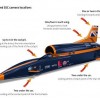To Catch a Ferrari
The race is on for high-speed camera technology to keep up with the world’s fastest roller coasters
The title for fastest roller coaster in the world belongs to the formidable Formula Rossa at Ferrari World in the United Arab Emirates. This beast of a ride is designed to look like riders are sitting in Ferrari Formula One race cars—and feel even faster than Ferrari’s (or anyone’s) most powerful car. It’s so fast that riders are required to wear face protection to protect against collisions with airborne particles or insects as the train accelerates to 240km/h in less than 5 seconds.
There is a reason why Ferrari set out to build the fastest coaster, and why it probably won’t hold the title for long. The theme park industry is an incredibly competitive one. Parks are in constant battle for guests, facing the never-ending pressure to have the tallest, fastest, and most entertaining rides in the business. As ticket prices rise, theme parks, attractions and their suppliers are scrambling to add value to their venues and enhance the guest experience.
According to Picsolve, a leading image capture partner to the leisure and entertainment industry, the “all-inclusive or wrist-band” admission package is adding technology. Including photo sets in these entrance packages is a growing trend, predicted to become less of an added bonus than the new norm. All of this competition is great for innovation in ride technology. However as rides get faster, and the demand for souvenir photos increases, camera systems will need to evolve too.
The demand to be seen
People love to share photos. Photos of their day-to-day lives, friends and families, and of the things they see and do. This desire is naturally heightened when they are on vacation or doing something special – like visiting a theme park.
The proof, if you need it, is in the statistics. In 2012 the amount of photos shared annually on social media shot up to over 500 million for the first time. In 2013 that number jumped up to more than 1.2 billion, and before the close of 2014 more than 1.8 billion photos had been shared on platforms like Facebook, Snapchat, WhatsApp and Instagram. And as mobile and photo-sharing technology evolves it’s only natural that the retail applications evolve with them.
Not an easy picture
What does it take to capture pin-perfect photos of individual riders on a roller coaster going 100km/hr?
The Formula Rossa achieves the aforementioned cheek-flapping grin-inducing speed of 240km/h. Imagine capturing a perfect still image of something traveling that fast. Now imagine that you have to capture multiple perfect images of every single person and their goofy, mid-ride faces at that speed. These are not easy pictures to take.
Super coasters like the Formula Rossa notwithstanding, the average roller coaster travels at closer to 100km/h, so for simplicity’s sake, let’s stick to that nice round number. Setting up a system that consistently takes pin-perfect photos of riders traveling at that speed and often at challengingly steep angles requires some fast cameras. These cameras also have to withstand wind, weather and extreme temperatures.
So, just how fast does a camera have to be to grab high quality photos of riders?
If the roller coaster travels at a speed of 100km/h or 27m/s, and the 1k x 1k camera is imaging a 1m field of view, the triggered exposure must be fast enough to stop the motion clearly, at least 1/30,000s (at a frame rate of approximately 30fps) to acquire an image with absolute clarity – and worth sharing on Facebook.
Other factors that affect the quality of the images include luminance (tricky in an outdoor environment shifting from day to night), aperture size, shutter speed, and field of view. Typically imaging systems are customized to a specific ride’s unique conditions. Camera systems need to be capable of high-speed multi-shot bursts triggered by the motion of the train and coordinated to go off at an exact moment like these well-timed examples. Intelligent iris control allows the camera to adjust automatically to changing weather and lighting. Fibre optically connected GigE Vision cameras like the Genie TS enable quick image transfer to a nearby photo booth so riders can view and pay for their photos within seconds.
As theme park rides get faster and the demand to capture and share our best and most thrilling moments builds, camera systems will need to evolve and optimize right along with them, and when the checkered flag drops, as Ferrari knows, the race is on.



 Attempt to break world land speed record puts vision system to the test
Attempt to break world land speed record puts vision system to the test  Dr. Mark Whorton: The Future of Earth Imaging
Dr. Mark Whorton: The Future of Earth Imaging 